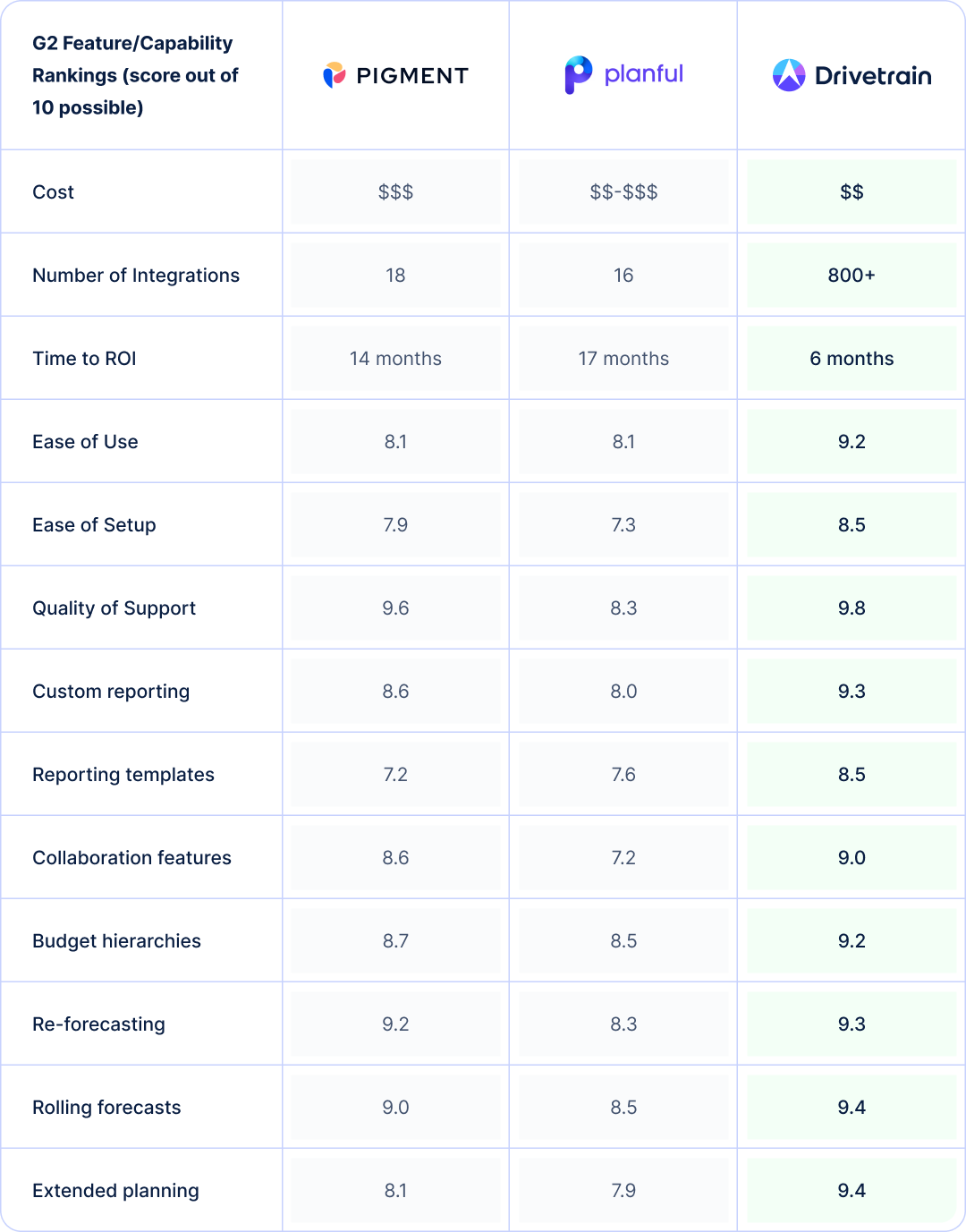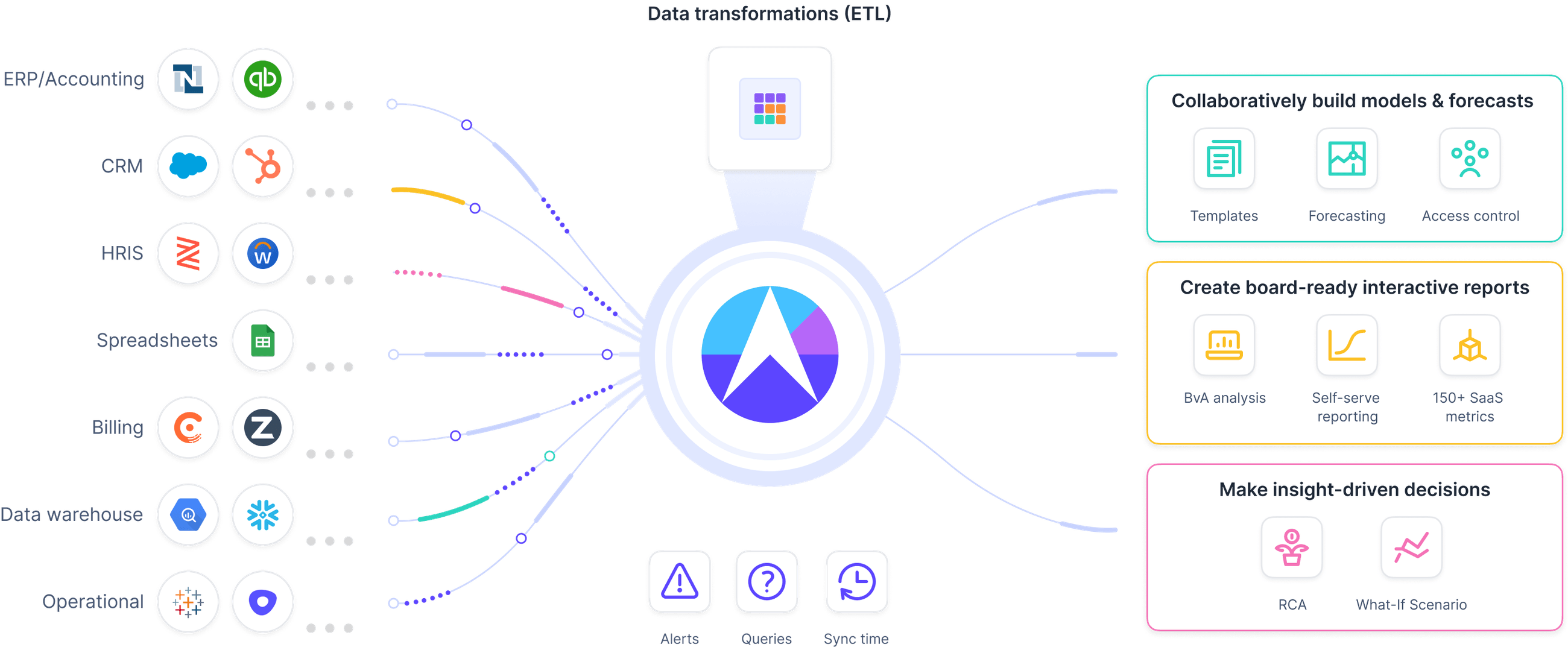Every FP&A platform promises scalability, agility, and reliability, but only some truly deliver. Before you invest in your next FP&A tool, see how they stack up against each other. This guide helps finance leaders compare Pigment and Planful. We'll look at key features like usability, integrations, modeling, governance, reporting, and performance. We'll also discuss where both platforms don't meet the needs of dynamic teams and how Drivetrain fills those gaps with quicker setup, reliable data pipelines, finance-led modeling, and trustworthy reporting for CFOs.
When CFOs evaluate FP&A software, they’re not looking for bells and whistles. They’re looking for actionable outcomes and ROI. Their FP&A buying decisions are based on speed, trust, and the platform's scalability. They consider time-to-value, model flexibility, integrations, governance, performance at scale, and total cost of ownership (TCO).
User reviews and analyst comparisons consistently talk about quick deployment and faster ROI. Strong data integrations with ERP, CRM, and HR systems are a priority. Governance and version control are also necessary to make the collaboration secure and auditable. They also make sure that the FP&A tool is scalable across multiple entities and currencies.
While both Pigment and Planful tick many of these boxes, they may not fully meet all your FP&A needs. This guide helps you understand where these two platforms excel, where they fall short, how Drivetrain as an alternative addresses those gaps, and what to consider when picking an FP&A platform for your organization.
Evaluating Pigment: strengths, weaknesses, best fit
Pigment is an enterprise FP&A platform suitable for finance teams handling multi-entity budgets. It is the cloud-native alternative to spreadsheet-driven business decision-making processes.
Pigment limits fast-growing teams with its steep learning curve. When teams move from simple scenarios to complex, multi-dimensional models, it takes time to master formulas, complex hierarchies, and strict permission controls. Users also mention data access issues and reporting complexity with large datasets or enterprise-scale consolidations.
What are Pigment’s core strengths?
- Finance-friendly modeling: Build driver-based models to prototype and iterate without much scripting.
- Scenario and what-if depth: Easily supports various forecasting methods and quick scenario comparisons.
- Quick setup for standard models: Standard templates are available for common planning models, such as workforce, revenue, and expense plans, allowing teams to start using the platform with minimal delay.
- Powerful visualization and dashboards: Pigment's native charts and built-in dashboards simplify data interpretation and make executive reporting easier.
What do Pigment users struggle with?
- Complicated modeling syntax: The platform’s SQL-like syntax imposes a steep learning curve on finance users.
- Scalability and performance limits: Large or very detailed datasets can slow down calculations and report updates, often forcing teams to combine or simplify their data to get acceptable performance.
- Governance becomes heavy at scale: As an organization grows, managing detailed access rules, audit trails, and version control for all its entities and users becomes complex.
- Limitations in advanced consolidation and calculation capabilities: For complex consolidation tasks, such as intercompany eliminations, currency translation, and statutory close workflows, you might need to use workarounds or additional tools.
- Complex integration/ETL requirements: Only 18 native integrations for common systems means that organizations with multiple systems to connect with and/or complex data pipelines to build will require middleware or IT support to do it.
When Pigment makes sense
Pigment is typically adopted by mid‑market to enterprise finance teams for collaborative, finance‑led planning across multiple entities and functions (FP&A, RevOps, People), enabling fast iterations on what‑if analyses, scenario comparisons, and rolling forecasts using shared models and boards. It is less suitable for requirements involving transaction‑level consolidations or a full statutory close engine and presumes data consolidation or simplification is handled via middleware or IT support.
Evaluating Planful: strengths, weaknesses, best fit
Planful is an established corporate performance management (CPM) platform with tools for streamlining budgeting, forecasting, consolidations, and financial close. It is suitable for enterprise and upper-mid-market finance teams that need repeatable close and reporting workflows across multiple entities. It uses established templates, built-in reporting, and clear workflows to simplify financial planning and month-end close.
However, Planful has limitations in modeling and user-defined dimensions. Deep customizations and complex integrations are time-consuming. Customers say that dimension limits and the need for middleware for large data transfers or real-time updates are problematic. These constraints mean Planful is a less appealing option for fast-growing mid-market finance teams and enterprises that need granular insights, multi-dimensional models, or custom data pipelines.
What are Planful’s core strengths?
- Built-in budgeting and close processes: Reduce ad-hoc steps, minimize manual errors, and shorten month-end timelines.
- Reporting and consolidation features for repeatability: Out-of-the-box reporting and consolidation features make month-end and variance workflows more consistent and auditable.
- Controls, governance, and auditability: Approval workflows, detailed audit logs, and role-based controls are designed to meet the needs of compliance-focused finance teams.
What do Planful users struggle with?
- Ceiling on model complexity: The platform’s structure makes it hard to model complex nested hierarchies or many driver combinations without redesigning the model.
- Performance issues: The interface and workflow logic are less intuitive compared to newer tools. Load or refresh times are long when dealing with large reports or many dimensions.
- Integration friction: Complex data sources and large data loads need middleware or extra engineering to handle reliably.
- Longer rollout for custom use cases: Average implementation time is five months. Custom requests take longer because they require the assistance of third-party consultants, which increases both time and cost.
- Restricted ad-hoc and transaction-level analysis: Highly granular drill-downs and free-form slice-and-dice reporting options are restricted, limiting the ability to perform in-depth operational analysis.
When Planful makes sense
Planful is typically used by mid‑market and enterprise finance teams with centralized, repeatable close and budgeting across multiple entities. It emphasizes reporting and consolidation to support month‑end control and auditability, and is less suitable for organizations needing highly flexible, rapidly deployable modeling for evolving processes.
It fits teams that run standardized budgeting, forecasting, and close via templates and guided workflows, require audit‑ready reporting and consolidated statements with minimal configuration, and prioritize predictable close cycles and compliance over extensive ad hoc or what‑if modeling.
Pigment vs. Planful: where they differ most for CFO priorities
Comparing Pigment vs. Planful, we find that they solve core FP&A problems, but each has its limitations. Pigment is designed for flexibility and collaborative planning to help teams transition away from spreadsheets. Planful’s focus is on repeatability and control with pre-built budgeting and financial close workflows, and a strong emphasis on governance. This makes it suitable for finance teams in highly regulated industries that need strong compliance.
Both vendors fall short in meeting the needs of finance teams at rapidly growing companies with multi-entity setups, as they currently do not offer fully autonomous AI planning. Planful has begun integrating generative AI assistants into workflow guidance and report commentary, but its AI use cases are largely assistive. Pigment’s AI roadmap focuses on improving modeling flexibility, including features like predictive drivers and anomaly detection for scenario planning. However, most of these capabilities are still in limited rollout or beta.
Also, the ownership models are not transparent, integrations are minimal, and transaction-level reporting is missing. For teams needing real-time data, very deep multi-dimensional models, or heavy statutory consolidation, these gaps are the decision drivers. Choosing between Pigment vs. Planful is about deciding which trade-offs your organization can manage rather than picking an FP&A platform that aligns with your needs completely.

Pigment vs. Planful and where they both fall short for dynamic finance teams
Modern finance teams need reliable forecasts, trustworthy data, and quick analytics that don't require a team of full-time specialists. Both Pigment and Planful work in specific scenarios, but they often leave operational gaps that become more apparent as finance teams scale, adapt to market changes, or try to move faster than their quarterly planning cycles. These aren't minor inconveniences. They're friction points that slow reforecasting, increase dependency on specialists, and fragment the "single source of truth" necessary for accurate and fast-paced financial planning.
Limited integrations increase maintenance burden
Pigment positions itself around business-owned integrations. However, it only offers 18. Planful offers only 16 native integrations. While the native integrations these platforms offer handle common systems well, anything beyond basic use cases, such as custom data pipelines, near-real-time feeds, or highly transformed data, requires middleware or custom API work, both of which tend to produce fragile data pipelines. For example, Planful claims to offer “thousands of pre-built connectors.” However, accessing these connectors requires a Boomi account. It is unclear whether this requires a paid subscription to Boomi’s integration platform or if those costs are included in the Planful subscription.
Both focus on suite-centric integrations with big enterprise software suites (e.g., Oracle, SAP, Workday) and their standard data models to reduce upfront custom work. But if you’re not invested in one of these suites, you’ll have to pay to build your own data flows that will require engineering support as changes occur. Whenever you need to make changes like adding new fields, entities, or currencies, both platforms need manual adjustments. The integration friction becomes a bottleneck every time the business evolves.
Lack of modeling agility and challenges in making changes
Business agility depends on finance teams being able to quickly modify their FP&A models without relying on IT. Platforms like Pigment claim their models are "business-owned," but the reality is complicated—often, true business ownership remains an elusive goal. Complex models, permissions, and calculations rely on skilled (and expensive) IT consultants.
Advanced models with nested hierarchies, complex formulas, and granular permissioning often require specialized knowledge that many finance teams don't have in-house. One G2 reviewer noted: "Despite Pigment's comprehensive onboarding experience facilitated by a knowledgeable team, some end users may find it challenging to fully dive into the multitude of features offered, especially those accustomed to years of using simpler tools like Excel."
Planful uses structured workflows and templates, which are great for standard budgeting and close processes. However, this approach limits flexibility for highly customized or complex models. A G2 reviewer confirmed this rigidity: "The biggest issue I've run into with Planful is that some of the setup and customization can be a bit rigid. For example, if a reporting structure or planning template doesn't quite fit how we manage grants or contracts, it takes some work to get it adjusted".
Both platforms require ongoing IT or specialist support. Whenever finance needs to change a formula, add a new scenario, or react to market shifts, they're stuck. They must either learn complex code or wrestle with the rigid template. This constant need for platform maintenance creates a bottleneck for finance teams that need to reforecast as data changes or quickly test multiple "what-if" scenarios.
Reporting challenges: exports, drift, and doubt
The idea of a "single source of truth" falls apart when finance teams have to export data to Excel or BI tools just to finalize board reports. Both Pigment and Planful have reporting limitations that force teams to use workarounds, which leads to version control problems and erodes trust in executive reports. These problems worsen during financial close and forecasting. Outdated data or changes in upstream systems often require last-minute manual reconciliations.
Planful's built-in reporting engine is designed for standardized financial statements and consolidation workflows. However, when finance teams export data to Excel or Tableau for presentation-ready formats, it breaks the single source of truth and adds extra reconciliation steps each time the numbers need to be finalized.
Pigment offers more modern reporting with collaborative boards and visual flexibility, but a G2 user says, "UX can be a bit clunky at times, especially when designing boards." Managing granular access controls across multiple entities, teams, and report types becomes administratively heavy, limiting true self-serve access for non-finance stakeholders.
Both platforms face common reporting pain points, such as inconsistent metric definitions across models and versioning gaps in the report. One Pigment user mentioned: "I would appreciate it if the update/modification history was easier to follow (it can be difficult to see who has made what change and when)." When audit trails are unclear, finance teams waste time tracking individual changes instead of analyzing the reasons behind financial shifts.
This leads to a lack of confidence in data, forcing finance teams to rely on spreadsheets.
Pigment vs. Planful and how Drivetrain outperforms both
Drivetrain is a comprehensive, AI-native FP&A platform designed to fix the operational issues CFOs care about most. This includes extensive, built-in integrations that simplify data transfers, flexible multi-dimensional modeling without limits, and dependable implementations that deliver quick value.
For example, Planful relies on third-party integration tools, and Pigment needs middleware for large data feeds. In contrast, Drivetrain offers more than 800 plug-and-play integrations, most of which can be installed in minutes. Easy, native integrations for any system, combined with machine-learning based anomaly detection and AI-powered data transformations with Drive AI, ensure all the data flowing into the platform is reliable and model-ready.
Unlike Planful, Drivetrain also supports unlimited multi-dimensional modeling, which directly resolves modeling and ownership challenges that often force teams to choose between detail and speed.
Drivetrain focuses on governance, scalability, and practical AI that finance teams can use right now. The dedicated onboarding team and strong service level agreements (SLAs) ensure implementation in 4–6 weeks and accelerate your return on investment (ROI) to just six months compared to Pigment’s 14 months and Planful’s 17 months. Drivetrain also features natural language formulas, clear audit trails, and customer feedback praising minimal manual intervention in forecasting and digestible reporting.

Predictable implementation path with resilient data pipelines
Drivetrain offers a quick and structured implementation cycle that takes just weeks, not months, unlike the longer rollouts seen with Pigment and Planful. Each deployment has clear milestones, from getting data ready to setting up your forecast, and a dedicated customer success manager to help you meet them. This approach ensures early success with high-impact models before expanding to broader use cases.
Drivetrain's 800+ built-in integrations eliminate the need for third-party APIs or middleware. These connections are robust, automatically adapting to new fields, entities, or currencies without disrupting your data. It speeds up implementation and cuts down on the constant maintenance and rework seen with tools like Pigment and Planful.
Finance-owned modeling without the IT/Specialist “tax”
Drivetrain puts finance teams fully in control of their models. Analysts can easily create, update, and adjust assumptions or scenarios without relying on IT or external consultants. The platform’s finance-first modeling layer lets users manage drivers, formulas, and hierarchies through an intuitive interface designed for domain experts, not coders.
This approach eliminates the “specialist tax” that slows Pigment and Planful customers and directly addresses the agility and maintenance pain points raised by user feedback on both competitors. For example, users can adjust forecasts or run a what-if analysis instantly as conditions change, and reforecasting cycles are cut from weeks to days, allowing technical teams to focus on valuable data engineering instead of daily model maintenance.
Shared definitions, single truth, and governed reports teams can trust
Drivetrain provides clear and reliable reports. You get built-in, finance-ready reports for your board and management packs. These reports are shareable with role-based views, meaning you don't need to export data to Excel or other BI tools. A standardized metric catalog ensures every department, from finance to operations, uses the same indicators and numbers.
Each report and forecast includes a clear audit trail, version control, and approval process, ensuring every change has context and ownership. For advanced visualization, Drivetrain integrates seamlessly with BI tools while maintaining consistent metric definitions. With strong integrations, reports stay up-to-date even as source systems change, giving CFOs a reliable single source of truth and significantly reducing rework during close times.
A decision framework for CFOs
Selecting an FP&A platform is not about ticking off features on a checklist. It’s about confirming whether the tool can keep up with your team’s speed, accuracy, and governance as your business grows. Here’s a simple, practical checklist to help CFOs evaluate FP&A tools:
- Roles and timelines: Define who drives implementation, finance, IT, or consultants, and clarify the ownership split post-go-live. Relying heavily on external specialists can slow down updates and increase your time-to-value. Focus on clear milestones, internal training, and quick-win models, like budgeting or reforecasting, to build momentum within the first few weeks.
- Integration scope: Map which systems, like ERP, CRM, HRIS, and data warehouse, will connect and how frequently they sync. Relying on limited connectors or custom APIs can lead to hidden costs and project delays. It's better to choose platforms with a wide range of integrations that are easy for your business to manage and won't break the data flow when the original data source is updated.
- Governance requirements: Check if the platform’s permission settings, audit trails, and approval workflows meet your company’s compliance needs. Rules that are too complex can slow down teamwork, but rules that are too loose can create risks. A good FP&A tool finds the right balance between flexibility and control, so governance becomes a natural part of your workflow instead of a roadblock.
- Scale and performance: Test how the platform behaves under real-world loads like multiple entities, currencies, and concurrent users. Some tools slow down under heavy datasets or complex models. Ask for demonstrations using your data volume to gauge responsiveness and reporting speed before committing.
- Pricing and renewal risks: Don't just look at licensing costs. Also consider implementation costs, how much you'll rely on consultants, and renewal pricing. Users often complain about unpredictable service costs and fees for changes over time. Choose vendors with clear TCO, stable pricing, and good support.
Choosing your FP&A partner
Pigment may be a good fit for some finance-led planning teams that value visual modeling. And Planful can work well for organizations with mature and centralized finance functions that prioritize governance, auditability, and repeatable close cycles. But what about the tradeoffs?
Drivetrain, however, combines the strengths of both while addressing their shortcomings. With fast, predictable implementations, resilient data pipelines, finance-first modeling, seamless collaboration, and governed reporting, Drivetrain gives CFOs everything they need to run a connected, high-velocity planning process at scale.

Schedule a demo to see how Drivetrain can modernize your FP&A to achieve faster closes, sharper forecasts, and confident decisions.
Frequently asked questions
For modern finance teams, an FP&A platform's true value isn't measured by its dashboards. It's about how well it helps you work faster and maintain accuracy as you grow. Finance leaders evaluate platforms based on:
- Time-to-value: How quickly you can set up and start generating useful forecasts.
- Modeling flexibility and finance ownership: Can analysts update assumptions and drivers on their own, without needing help from IT?
- Integration scope: How strong and reliable the data connections are, and how they adapt to changes from the source.
- Governance and auditability: Role controls, version tracking, and workflow approvals that preserve compliance without slowing decisions.
- Performance at scale: The platform’s responsiveness across entities, currencies, and large data sets.
- Predictable TCO: Transparent pricing, low consultant dependence, and clear renewal terms.
These points directly address common user complaints such as long rollouts, brittle integrations, and unpredictable costs. They are the best way to tell if your next FP&A tool will truly keep up with your business.
Implementation timelines vary widely depending on the overall complexity of your data ecosystem and your models. Based on customer reviews, the teams that lean on outside consulting or middleware to support their implementations often face a longer implementation timeline than originally expected, sometimes lasting several months, instead of days or weeks.
In contrast, Drivetrain customers experience a go-live period of six weeks or less due to an implementation path with defined milestones, guided onboarding, and 800+ business-manageable integrations that eliminate brittle data connections.
To help keep your project on track and shorten implementation, we recommend:
- Setting clear milestones to track progress from data readiness to model validation and go-live.
- Assigning internal "superusers" so that your team is self-sufficient post-launch.
- Piloting priority workflows such as budgeting, forecasting, or reforecasting before expanding to broader planning areas.
According to user feedback, Pigment offers faster deployment than Planful due to its flexible modeling setup and lower IT dependency. Most mid-market companies with simple model requirements can go live in a few months. Planful, on the other hand, typically involves a longer rollout cycle because of its structured workflows, dimension constraints, and reliance on consultants for customizations.
For teams that demand both lightning-fast results and ironclad long-term resilience, Drivetrain is a solid alternative. Your team can benefit from the seamless prebuilt integrations and guided onboarding. Our milestone-based implementation plan is designed to roll out within 4-6 weeks and deliver ROI in just 6 months.
Vendor payback claims may rely on optimistic assumptions, so you should build your own model with conservative inputs. Best practice is to create scenario models that include:
- Time savings on reporting, forecasting, and close processes
- Headcount impact, such as reduced hiring needs
- Direct financial benefits, like lower consulting expenses or optimal use of working capital
- Indirect benefits, such as faster decision-making or better forecasting accuracy
Migrating FP&A systems is a big project, but it doesn't have to be painful. The success of the migration is determined by a clear blueprint, precise data mapping, and sufficient onboarding support. In the absence of these fundamentals, teams ultimately face possible disruptions in workflow, lost data, and unplanned-for costs.
Drivetrain reduces the complexity of migration with practical implementation support, prebuilt templates help you quickly replicate data and models, and flexible tools that adjust to your existing workflows. You will also be assigned a Customer Success Manager (CSM) and have access to a knowledge base and self-paced training modules. As one G2 reviewer put it, “The customer support team is always responsive and helpful, ensuring we get the most out of the tool.”

.svg)






.webp)



.svg)

